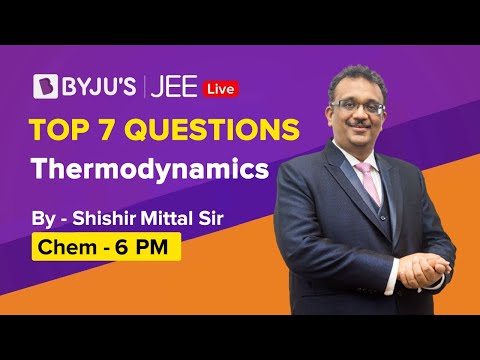It is a common experience that heat is transferred from one place to another. For example, the handle of a metal frying pan kept on fire, becomes hot after some time. The flow of heat from one place to another is known as the transmission of heat. There are three methods of heat transfer such as conduction, convection and radiation.
Download Calorimetry and Heat Transfer Previous Year Solved Questions PDF
JEE Advanced Previous Year Questions on Calorimetry and Heat Transfer
Question 1) A bullet of mass 5 g, travelling with a speed of 210 m/s strikes a fixed wooden target. One half of its kinetic energy is converted into heat in the bullet while the other half is converted into heat in the wood. The rise of temperature of the bullet if the specific heat of its material is 0.030 cal/g°C (1 cal = 4.2 x 107 ergs) close to:
(A) 87.5°C
(B) 83.3°C
(C)119.2°C
(D) 38.4°C
Answer: (A) 87.5°C
Solution:
According to the question, one half of its kinetic energy is converted into heat in the wood.
(½)mv2 ×(½) = msΔT
⇒ ΔT= v2/4s = (210 × 210)/(4 × 4.2 × 0.3 × 1000) = 87.5°C
Question 2) The specific heat of water = 4200 J/Kg/K and the latent heat of ice = 3.4 × 105 J/kg. 100 grams of ice at 0°C is placed in 200 g of water at 25°C. The amount of ice that will melt as the temperature of the water reaches 0°C is close to (in grams):
(A) 61.7
(B) 63.8
(C)69.3
(D) 64.6
Answer: (A) 61.7
Solution:
Here ice melts due to water.
Let the amount of ice that melts = mice
mwswΔθ = miceLice
mice = mwswΔθ/Lice
= (0.2 × 4200 × 25)/(3.4 × 105)
= 0.0617 kg = 61.7 g
Question 3) M grams of steam at 1000C is mixed with 200 g of ice at its melting point in a thermally insulated container. If it produces liquid water at 40°C(heat of vaporization of water is 540 cal/g and heat of fusion of ice is 80 cal/g], the value of M is
Answer: 40
Solution:
Using the principle of calorimetry
MiceLf + mice(40 – 0)Cw = mstreamLv + mstream(100 – 40)Cw
⇒ M(540) + M × 1 × (100 – 40) – 200 × 80 + 200 × 1 × 40
⇒ 600 M = 24000
⇒ M = 40 g
Question 4) When M1 gram of ice at 10°C (specific heat = 0.5 cal g-10C-1) is added to M2 gram of water at 50°C, finally no ice is left and the water is at 0°C. The value of latent heat of ice, in calg-1 is:
(A) (50M2/M1) – 5
(B) (5M1/M2) – 50
(C)(50M2/M1)
(D) (5M2/M1) – 5
Answer: (A) (50M2/M1) – 5
Solution:
Using energy conservation
Ereleased by water = Eused by ice
⇒ M2Sw(ΔT)water = M1Sice(ΔT)ice + M1Lfusion
M2 (1)(50) = M1(½)(10) +M1Lfusion
50M2 – 5M1 = M1Lfusion
Lf = (50M2/M1) – 5
Question 5) A metal rod AB of length 10x has its one end A in ice at 0°C and the other end B in water at 1000C. If a point P on the rod is maintained at 400°C, then it is found that equal amounts of water and ice evaporate and melt per unit time. The latent heat of evaporation of water is 540 cal/g and latent heat of melting of ice is 80 cal/g. If the point P is at a distance of λx from the ice end A, find the value of λ.[ Neglect any heat loss to the surrounding]
Answer: 9
Solution:

For heat flow from P to 0
For heat flow from P to B
(given , dm1/dt = dm2/dt)
Dividing (1) and (2) and solving, we get λ = 9
Question 6) Two spherical bodies A (radius 6 cm) and B (radius 18 cm) are at temperatures T1 and T2, respectively. The maximum intensity in the emission spectrum of A is at 500 nm and that of B is at 1500 nm. Considering them to be black bodies, what will be the ratio of the rate of total energy radiated by A to that of B?
Answer: 9
Solution:
As per Wein’s displacement law
As per Stefan’s law,
Question 7) Two spherical stars A and B emit blackbody radiation. The radius of A is 400 times that of B and A emits 104 times the power emitted from B. The ratio λA/λB of their wavelengths λA and λB at which the peaks occur in their respective radiation curves is
Answer: 2
Solution:
According to Wein’s displacement law
λmATA = λmBTB
Ratio of energy radiated per unit time
⇒ λA/λB = 2
Question 8) Ice at -20°C is added to 50 g of water at 40°C. When the temperature of the mixture reaches 0°C, it is found that 20 g of ice is still unmelted. The amount of ice added to the water was close to
(Specific heat of water = 4.2 J/g/°C
Specific heat of ice = 2.1 J/g/°C
Heat of fusion of water at 0°C = 334 J/g)
(A) 50 g
(B) 100 g
(C) 60 g
(D) 40 g
Answer: (D) 40 g
Solution:
Let m gram of ice be added
From principle of calorimeter
Heat gained by ice = Heat lost by water
20 × 2.1 × m + (m – 20) × 334 = 50 × 4.2 × 40
376m = 8400 + 6680
m = 40.1
Question 9) When 100 g of a liquid A at 100°C is added to 50 g of a liquid B at temperature 75°C, the temperature of the mixture, if 100 g of liquid A at 100°C is added to 50 g of liquid B at 50°C, will be
(A) 85°C
(B) 60°C
(C) 80°C
(D) 70°C
Answer: (C) 80°C
Solution:

Question 10) A copper ball of mass 100 gm is at a temperature T. It is dropped in a copper calorimeter of mass 100 gm, filled with 170 gm of water at room temperature. Subsequently, the temperature of the system is found to be 75°C. T is given by
(Given: room temperature = 30°C, specific heat of copper = 0.1 cal/gm°C)
(A) 1250°C
(B) 825°C
(C) 800°C
(D) 885°C
Answer: (D) 885°C
Solution:
According to the principle of calorimetry
Heat lost = Heat gain
100 × 0.1(T – 75) = (100 × 0.1 × 45) + (170 × 1 × 45)
10T – 750 = 450 + 7650 = 8100
⇒ T – 75 = 810
T = 885°C
Also Read:
Heat Transfer JEE Main Previous Year Questions With Solutions
Video Lessons
Thermodynamics – Important Questions

Thermodynamics

Comments